Complete Solutions to LC_TYPE of chapter FLUID MECHANICS of Class 11 book with complete answers and questions
| Class 11 | PHYSICS |
| Chapter | FLUID MECHANICS |
| CENGAGE PHYSICS | LC_TYPE |
| Number Of Questions | 9 |
| Academic Year | 2023-24 |
A cylindrical tank has a hole of diameter 2r in its bottom. The hole is covered wooden cylindrical block of diameter 4r, height h and density `rho//3`.
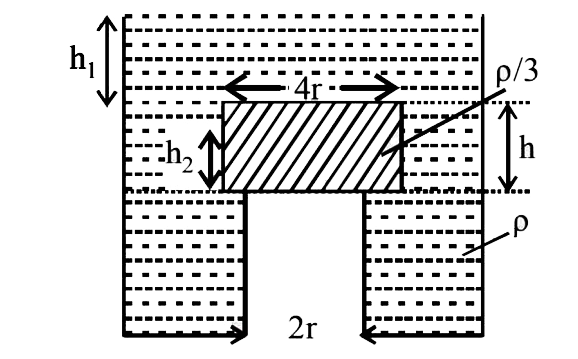
Situation I: Initially, the tank is filled with water of density `rho` to a height such that the height of water above the top of the block is `h_1` (measured from the top of the block).
Situation II: The water is removed from the tank to a height `h_2` (measured from the bottom of the block), as shown in the figure. The height `h_2` is smaller than h (height of the block) and thus the block is exposed to the atmosphere.
Find the minimum value of height `h_1` (in situation 1), for which the block just starts to move up?
View SolutionA cylindrical tank has a hole of diameter 2r in its bottom. The hole is covered wooden cylindrical block of diameter 4r, height h and density `rho//3`.

Situation I: Initially, the tank is filled with water of density `rho` to a height such that the height of water above the top of the block is `h_1` (measured from the top of the block).
Situation II: The water is removed from the tank to a height `h_2` (measured from the bottom of the block), as shown in the figure. The height `h_2` is smaller than h (height of the block) and thus the block is exposed to the atmosphere.
Find the minimum value of height `h_1` (in situation 1), for which the block just starts to move up?
View SolutionA cylindrical tank has a hole of diameter 2r in its bottom. The hole is covered wooden cylindrical block of diameter 4r, height h and density `rho//3`.
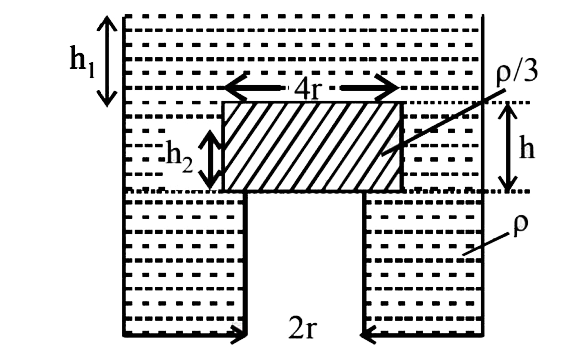
Situation I: Initially, the tank is filled with water of density `rho` to a height such that the height of water above the top of the block is `h_1` (measured from the top of the block).
Situation II: The water is removed from the tank to a height `h_2` (measured from the bottom of the block), as shown in the figure. The height `h_2` is smaller than h (height of the block) and thus the block is exposed to the atmosphere.
In situation 2, if `h_2` is further decreased, then
View SolutionA fixed thermally conducting cylinder has a radius R and height `L_0`. The cylinder is open at the bottom and has a small hole at its top. A piston of mass M is held at a distance L from the top surface, as shown in the figure. The atmospheric pressure is `P_0`.
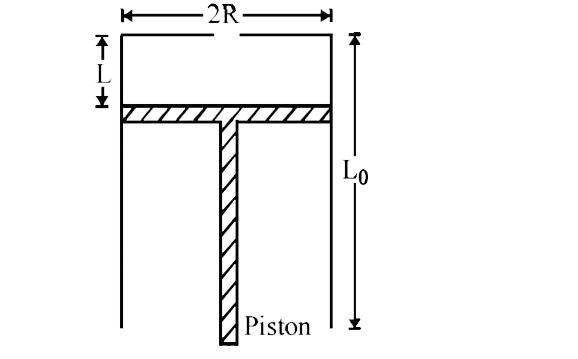
The piston is now pulled out slowly and held at a distance 2L from the top. The pressure in the cylinder between its top and the piston will then be
View SolutionA fixed thermally conducting cylinder has a radius R and height `L_0`. The cylinder is open at its bottom and has a small hole at its top. A piston of mass M is held at a distance L from the top surface, as shown in the figure. The atmospheric pressure is `P_0`.
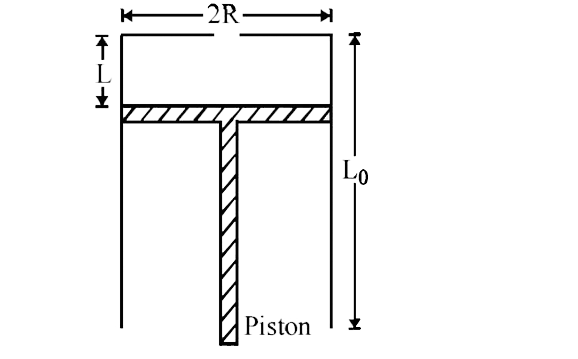
While the piston is at a distance 2L from the top, the hole at the top is sealed. The piston is then released, to a position where it can stay in equilibrium. In this condition, the distance of the piston from the top is
View SolutionA fixed thermally conducting cylinder has a radius R and height `L_0`. The cylinder is open at its bottom and has a small hole at its top. A piston of mass M is held at a distance L from the top surface, as shown in the figure. The atmospheric pressure is `P_0`.
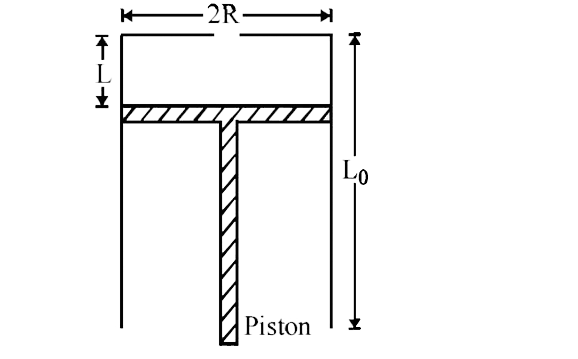
The piston is taken completely out of the cylinder. The hole at the top is sealed. A water tank is brought below the cylinder and put in a position so that the water surface in the tank is at the same level as the top of the cylinder as shown in the figure. The density of the water is `rho`. In equilibrium, the height H of the water coulmn in the cylinder satisfies
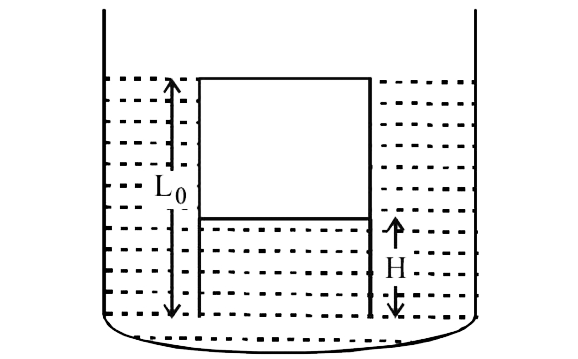
View SolutionA small spherical monoatomic ideal gas bubble `(gamma=5//3)` is trapped inside a liquid of density `rho` (see figure). Assume that the bubble does not exchange any heat with the liquid. The bubble contains n moles of gas. The temperature of the gas when the bubble is at the bottom is `T_0`, the height of the liquid is H and the atmospheric pressure `P_0` (Neglect surface tension).
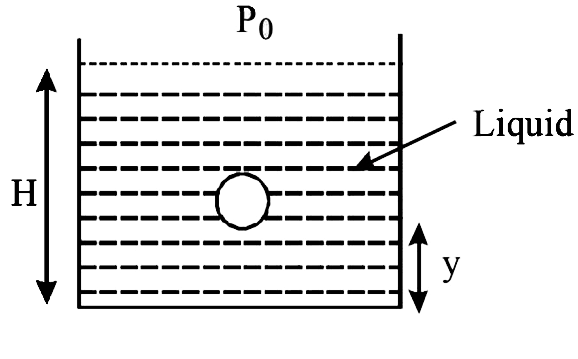
As the bubble moves upwards, besides the buoyancy force the following forces are acting on it
View SolutionA small spherical monoatomic ideal gas bubble `(gamma=5//3)` is trapped inside a liquid of density `rho` (see figure). Assume that the bubble does not exchange any heat with the liquid. The bubble contains n moles of gas. The temperature of the gas when the bubble is at the bottom is `T_0`, the height of the liquid is H and the atmospheric pressure `P_0` (Neglect surface tension).
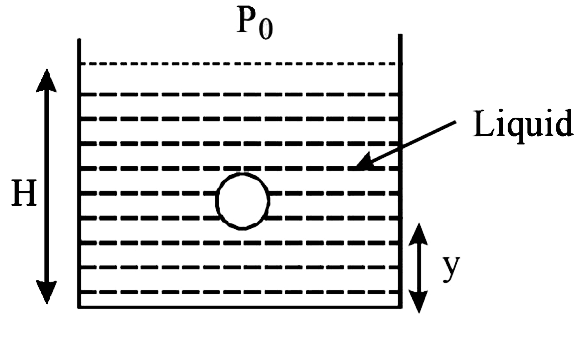
When the gas bubble is at a height y from the bottom, its temperature is-
View SolutionA small spherical monoatomic ideal gas bubble `(gamma=5//3)` is trapped inside a liquid of density `rho` (see figure). Assume that the bubble does not exchange any heat with the liquid. The bubble contains n moles of gas. The temperature of the gas when the bubble is at the bottom is `T_0`, the height of the liquid is H and the atmospheric pressure `P_0` (Neglect surface tension).
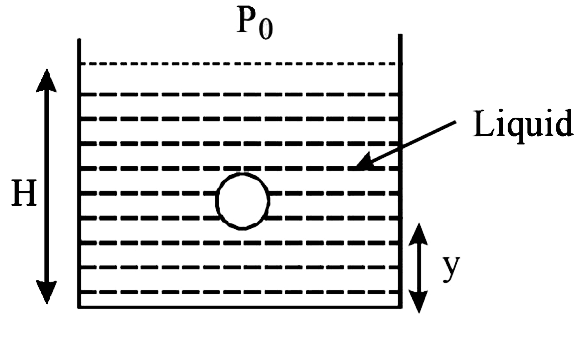
The buoyancy force acting on the gas bubble is (Assume R is the universal gas constant)
View Solution
LC_TYPE questions and complete solutions for chapter FLUID MECHANICS of CENGAGE PHYSICS (HINGLISH) of Class 11